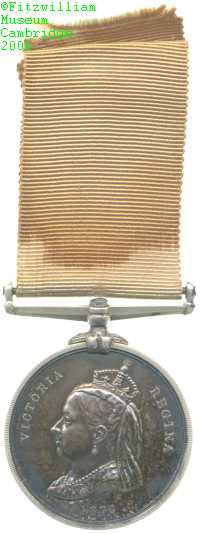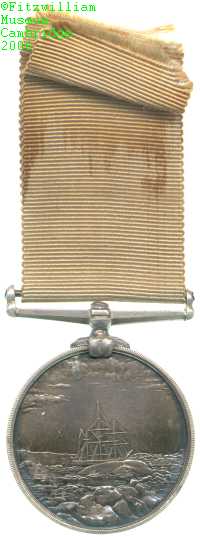
Obverse, a bust of Queen Victoria

Reverse, an ice-bound ship with heavy clouds in the background

Obverse, a bust of Queen Victoria |

Reverse, an ice-bound ship with heavy clouds in the background |
British medals for polar exploration were first issued in 1857, though their issue was not confined to British explorers, and was also made to those of other nations, both servicemen and civilians. This design was first issued in 1876, after the voyages of HMS Discovery and Alert under Sir George Nares.
The award of the medal was also sanctioned to the crew of the private yacht Pandora, under Captain Allen Young, which sailed Arctic regions in two voyages of 1875 and 1876. The aim of the voyages was to search for more relics of the end of the expedition of Sir John Franklin, who in 1845 took HMS Erebus and HMS Terror to chart the last unknown parts of the North-West Passage. The ships reached Baffin Island and were never seen again thereafter. The ensuing search for Franklin became a popular cause célèbre. Between 1850 and 1856 several lucky finds pieced together a story of ships locked in ice for two successive winters, starvation, and eventual death in an overland escape trek. Franklin himself seems to have died at King William Island on 25 April 1848. The ends of the party are still controversial.
Captain Young took the Pandora north to search for more evidence on the Franklin party's fate in both 1875 and 1876. Though the voyages were unsuccessful, on the latter the party also carried Admiralty despatches to the Alert and the Discovery. This service was deemed to entitle the crew to the Polar Medal.
This example was awarded to Able Bodied Seaman William Ricketts, who was crew aboard the Pandora. Lester Watson purchased it from the London dealer Spink at some point before 1928. It had previously been sold at the London dealers Glendinings on 25 September 1919, and was before that in the Lucas collection.
The Museum is grateful to Mr G. M. Stein and Rear Admiral J. A. L. Myres for information on the award of this medal.